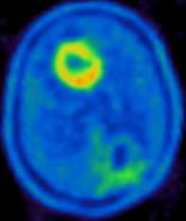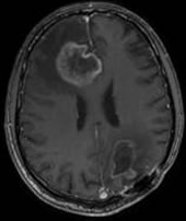PET for neurological/neuro-oncological questions
For neurological questions, tests of the regional cerebral glucose metabolism with FDG-PET are done among others to clarify various forms of dementia (e.g. Alzheimer’s disease, fronto-temporal dementia, Lewy-Body dementia, pseudo-dementia in case of depression). Especially in cases of early onset disease, a reliable early recognition and differentiation from other diseases like depression is important. Currently, multiple drugs are clinically tested to review whether the progression of dementia can be slowed down (predominantly of Alzheimer’s type). For specific cases we also administer F-18 labeled PET-Ligands for Amyloid imaging. In addition, we perform brain scans with specific ligands for the differential diagnosis of Morbus Parkinson or brain tumors to define the suitable biopsy location or therapy control. For meningeal tumors (meningiomas), Ga-68 DOTA-TATE is used for PET/CT imaging and enables the differential diagnosis, assessment of additional lesions and extent of meningiomas prior to neuro-surgery or prior to a percutaneous radiation therapy.
|
|
| Cross-sectional view through the brain of a patient, 62 years of age, with increasing memory disturbances. PET, performed with F-18 FDG showes a clearly reduced glucose metabolism at both parietal sides, the typical image seen inf Morbus Alzheimer. |
 |
 |
| Patient, 65 years of age, with glioblastoma in the left parietal lobe; the tumor was removed surgically. Afterwards, the patient was treated with combined radio chemotherapy. PET with F-18 FET (left image) was performed for evaluation of disease recurrence. The treated tumor (left) only shows a small increased FET-uptake at the rim, corresponding to postoperative changes after surgery; a tumor recurrence could be excluded. However, the second lesion at the right frontal lobe, shown in the MRI (right image), shows clearly increased FET uptake and represents vital, metabolically active tumor recurrence. | |

